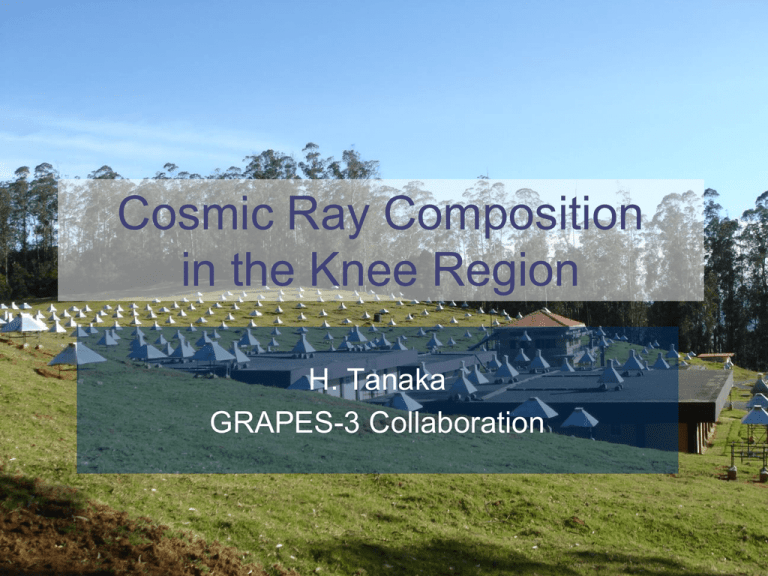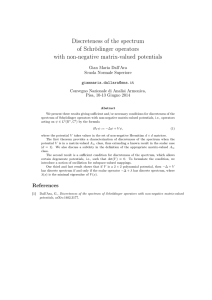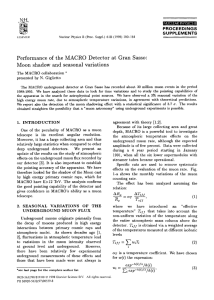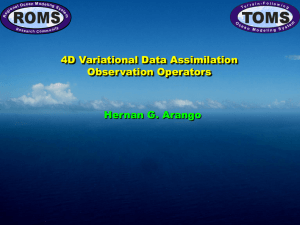grapes-3
advertisement

Cosmic Ray Composition in the Knee Region H. Tanaka GRAPES-3 Collaboration 1 Cosmic Rays TeV PeV EeV ZeV High Energy Particle from outside of the Earth 107~1020eV Power Low Spectrum E-γ Particle Type Electron, Proton ~ Iron Origin Energy Spectrum SNR? 2 Knee in Energy Spectrum 1015eV H Fe ? Fe H What is the cause of knee ? Limit of Acceleration Leakage from the Galaxy or others Measurement of nuclear composition and their energy spectrum could be one of the key to the solution. 3 Air Shower Experiments GRAPES-3 KASCADE Tibet AS Obs. Height 2200m 100m 4300m Density of Particle Detector 1det / 55m2 1.8% 1det / 167m2 1.3% 1det / 56m2 0.9% Other Observations 560m2 Muon Det. 80m2 Burst Det. Features Larger Statistics Lower E Threshold 800m2 Muon Array 300m2 Hadron Det. 128m2 MTT etc. Larger Statistics Lower E Threshold Tibet ASγ KASCADE GRAPES-3 GRAPES-3 has both of dens array and large muon detector at the high altitude. 4 GRAPES-3 Experiment Location: Tamil nadu, Ooty 2,200m (800g/cm2) SC Charged Particle (electron) Detector: Plastic Scintillator 1m2, 5cm thick x400 (8m separations) MU Muon Detector: 16 detectors (>1GeV) total 560m2 Observation: The number of electrons and the number of 5muons Shower Size LOG N2.5dI/dN [m-2sr-1s-1N1.5] LOG Size Spectrum Energy? Composition? MC, muon 6 Particle Type and Energy Estimated from Observations (MC) 6 Fe 1016eV LOG10(Nμ) Air Shower 5 Simulation Energy Fe 1015eV H 1016eV 4 Fe 1014eV H 1015eV 3 H 1014eV Nuclear Number 2 γ 1016eV 15 γ 10 eV Hadronic Interaction Model * SYBILL 2.1 * QGSJET01 γ 1014eV 1 3 4 5 LOG10(Ne) 6 7 Estimation of primary energy and nuclear mass number from the numbers of electrons and muons Model dependency for HE-Hadronic interaction 8 7 <number of detected muons> N- Ne diagram (M.C.) M.C. simulation CORSIKA QGSJET01, SIBYLL2.1, QGSJET-II 5 nucleous Proton, He, N, Al,Fe Observation 8 Multiplicity Distribution Al / Fe is fixed to 0.8 Ne: 105.0 - 105.2 marker Good sensitivity of cosmic ray mass Proton 0.3 He 0.4 N 0.3 Al 0.02 Fe 0.03 Observation 9 Energy Spectra Analysis dI/dE・E2.5 QGSJET Log(E) 1000 ALL H He N Al Fe dI/dNexNe2.5 100 10 Log10(E/TeV) MC 1 4 5 6 Log10(Ne) 7 10 Log10(Ne) All-particle Spectrum 11 Proton Spectrum Comparing with direct measurements is possible 12 Other Spectra He Al N Fe 13 Mean Mass Number Fe Al N He H Lower threshold enables data to compare with direct measurements. 14 Summary GRAPES-3 can get energy spectra of five groups utilizing muon multiplicity distribution. Change in proton spectrum and increase in mean mass with energy observed The results with SIBYLL and QGSJET-II agree with direct and KASCADE measurements. Extend spectrum to higher energy 15 THANK YOU 16 17 Air Shower Experiments KASCADE Tibet ASγ GRAPES-3 SPASE-2 BASJE 18 Method of EAS Observation BASJE Bolivia (550g/cm2) 46 SDs (1 or 0.83 m2 each) 12 SDs (4 m2 each) SPASE-2 South Pole (695g/cm2) 30 SDs (0.8m2 each) KASCADE Karlsruhe (1020g/cm2) 252 SDs Central Detector Muon Tracking Detector Tibet Asγ Tibet (606g/cm2) 500 SDs (0.5m2 each) Emulsion chamber Burst detector 19 Method of EAS Observation Location EAS Array GRAPES-3 Ooty 800g/cm2 400 SDs (1m2) BASJE Chacaltaya 550g/cm2 46SDs(1m2) 12SDs(3m2) SPASE-2 South Pole 695/cm2 30 SDs (0.8m2) KASCADE Karlsruhe 1020g/cm2 252 SDs (3.2m2) Tibet ASγ Yangbajing 606g/cm2 789 SDs (0.5m2) 20 Low Flux of Cosmic Ray around Knee Low Flux 1 particle in 1m2 in a year (>1015eV) Poor statistics in Direct Method Air Shower Observation above 1015eV 21 Important Matters in Observing Cosmic Ray around Knee To get enough statistics (Lower flux for higher cosmic rays) 1 particle in 1m2 in a year Air Shower Observation above 1015eV Sensitivity of Cosmic Ray Mass The number of Muon Large Area Muon detector Solve the Uncertainty of Monte Carlo (high energy phenomena) Compare the observation with direct measurements Density Shower Array for lower threshold energy GRAPES-3 Experiment 22 The First Report of Knee “On the Size Spectrum of Extensive Air Showers” G.V. Kulikov and G.B. Khristiansen Journal of Experiment and Theoretical Physics, 1958 Break of size spectrum was reported between 106 – 107. The cause of knee is not yet clear for 50 years. How are Recent Observations? 23 Energy Spectrum 24 Air Shower Observation Low Energy Particle 60GeV High Energy Particle >1013eV Primary particle ATMOSPHERE , e MC GROUND Muon Detector Particle Detector Array Observation 25 Direct Measurements JACEE Japanese American Cooperative Emulsion Experiment Balloon Experiment 1 - 1000 TeV The Antarctic Emulsion Chamber X-ray film Lead Plate RUNJOB RUssia Nippon JOint Balloon experiment Balloon Experiment JACEE 10 - 1000 TeV Kamchatka to Moskva 26 Mean Mass Number Much difference among them! 27 Important Matters in Observing Cosmic Ray around Knee To get enough statistics (Lower flux for higher cosmic rays) Sensitivity of Cosmic Ray Mass Solve the Uncertainty of Monte Carlo (high energy phenomena) 28 x = -11.8m y = 27.3m s = 0.91 LOG 検出粒子数 検出粒子数 サイズ推定(横方向フィット) コアからの距離(m) シャワーサイズ 1.82×105 r r rm s 2.0 r 1 rm NKG関数 29 s 4.5 ミューオントラック検出装置 検出装置 1層58 本の比例計数管 (6m×10cm×10cm) 4 layers 交互に組まれた4層で トラックを識別 合計16台(560m2) E>1GeV 58 counters 6m 30 Observation EAS Data 2000 – 2001 (560days) Shower Number 6×108 Shower Rate 13Hz Shower Selection Core Location (>80m) Zenithal Angle θ < 25o Monte Carlo Simulation CORSIKA QGSJET-II (CORSIKA6.50) SIBYLL 2.1 (CORSIKA6.50) QGSJET01 (CORSIKA6.02) Primaries Proton, He, N, Al and Fe 31 Expanded GRAPES Collaboration (1) TIFR, Mumbai: H.M. Antia, S.K. Gupta, P.K. Manoharan, P.K. Mohanty, P.K. Nayak, H. Tanaka, S.C. Tonwar (2) Osaka City University, Japan: S. Kawakami, Y. Hayashi, S. Ogio, A. Oshima (3) Aligarh Muslim University, Aligarh: Shakeel Ahmad, Badruddin, R. Hasan (4) APS University, Rewa: A.P. Mishra, P.K. Shrivastava (5) BARC, Mumbai: R. Koul, G.N. Shah (6) J.C. Bose Institute, Kolkata: S. Ghosh, P. Joarder, S. Raha, S. Saha (7) Gauhati University: R. Baishya, A.G. Baruah, K. Boruah, P.K. Boruah, P. Datta, J. Saikia (8) IIA Bangalore: D. Banerjee, P. Subramanian (9) North Bengal University: A. Bhadra (10) R.D. University, Jabalpur: R. Agarwal, S.K. Dubey, Santosh Kumar END Thanks for your kind attention! 32 The Number of Electron and Muon 33 Target for present experiment getting the size spectrum and muon multiplicity distribution Using M.C., energy spectrum of nucleus can be deduced from these results To achieve this, compact array (high density SD) and muon detectors with large area are required. In this experiment our energy range is overlapping with direct measurement (Balloon exp.). It means we have an anchor point, even though our results are totally M.C. dependent. 34 Location of GRAPES-3 Ooty Air Shower Experiment •日 印 :共 / /同 i n研 d i究 a -( t oO u rC i sU m ., h t t p •Location Mt. Ooty, South India E 76.7° N 11.4° 2,230m a.s.l. (800g/cm2) 35 Future Expansion Plans to observe higher energy cosmic rays Shower Array Muon Detector New Muon Detector 100m2 Hadron Calorimeter Radio Array (30-70MHz) Neutron Monitor Radio Telescope (326MHz) 1km2 Array 36 空気シャワーシミュレーション CORSIKA ハドロン相互作用モデル DPMJET ミューオン数 HDPM 110m a.s.l. 2-D Half maximum D.Heck et al., Proc. ICRC27, 233, 2001 GRT + minijet 空気シャワー向け SIBYLL 電子数 GRT + minijet QGSJET 現象論的モデル neXus GRT + minijet minijet 空気シャワー向け VENUS GRT(Gribov-Regge Theory) 37 ハドロンモデルの影響 1 PeV 鉄 電子数 ミューオン数 両者とも ~10% 程度の違い 38 <検出ミューオン数> ハドロンモデル依存性 QGSJET Fe QGSJET Proton CORSIKA SIBYLL Fe OBS QGSJET SIBYLL SIBYLL Proton Log(サイズ) 39 Knee のモデル 加速 1.超新星残骸での加速 2.超新星衝撃による加速 3.斜め衝撃波による加速 4.多様な超新星による加速 5.単一の超新星残骸での加速 6.銀河風での再加速 7.火の玉モデル 伝播 8.銀河からの漏れ出し 9.銀河からの異常拡散 10.銀河磁場中の拡散と漂流 11.乱流銀河磁場中の移流拡散 12.拡散漂流モデル 相互作用 13.光分裂と拡散 14.ニュートリノとの相互作用 40 Shower Cascade in the Atmosphere Air Shower Phenomena Primary particle Nuclear Cascade p, n, , 0, K, K0, … [decay] 0 + [8×10-17sec] + () [3×10-8sec] air Observation High Energy: Low Energy: COLLISION DECAY Electromagnetic Cascade Pair Creation e+ + eBremsstrahlung ee + 41 個々の成分の比較 個々の成分で比較できる! 42 シャワー到来方向 検出器へ粒子の入射する時間差から 到来方向を推定する ガンマ線点源の観測時の際は重要 43 時間差 (nsec) シャワー到来方向推定 (m) 44 Observation EAS Data 2000 – 2001 (560days) Shower Number 6×108 Shower Rate 13Hz Shower Selection Core Location (>80m) Zenithal Angle θ < 25o Monte Carlo Simulation CORSIKA QGSJET-II (CORSIKA6.50) SIBYLL 2.1 (CORSIKA6.50) QGSJET01 (CORSIKA6.02) Primaries Proton, He, N, Al and Fe The Number of Electron and Muon



